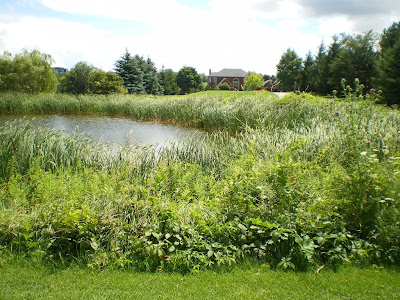There are many things to consider while planning a buffer zone planting. I personally like to follow the Permaculture principle of planning for at least three beneficial characteristics resulting from the one project. In order to do this successfully each site must be considered on an individual basis. The slope/grade, soil type, ecological zone, biodiversity, plant function and of course the golf course specific criteria of maintenance requirements, aesthetics and playability should all be considered while planning for the specific planting site. Careful observation goes a long way.
Some of the benefits realized by considering the above features of a planting project include erosion control, habitat corridor linkages, nutrient filtration, beautification, fuel conservation (no more mowing), shading (important role of many urban projects) and many more. The debate between native and non-native material is ongoing. when it comes down to it I evaluate material for buffer zones based upon the functions the client wants from the project. For example - if they are looking for something that is primarily aesthetically pleasing I'll use plants that produce showy flowers. This is where the designer, according to that permaculture principle mentioned above, must consider other beneficial characteristics of the plant if we want to provide more than just one function.
Lets use the native Blue Flag Iris, Iris versicolor for example. Iris's are commonly used in moist planting areas, and produce large flowers that golfers love. They are low enough to the ground so wont pose too much of a difficult feature to the game. Iris's can help define a hole by offering a visual reference for yardages or common out of bounds areas, and of course they provide nectar for bees and other insects.
Another lesser known but extremely beneficial characteristic is their ability to filter pesticides. This characteristic of accumulating fungicides from the soil is called bio-remediation (sometimes referred to as Phyto-remediation, especially when dealing with green plants) and is being used in various industries as a way of cleaning and restoring the land. However when employed on a golf course the technique is meant more to protect the environment in case of a spill or unexpected case of run-off.
“Studies from golf greens have shown that 5 percent to 10 percent of the total pesticides applied are lost in runoff. In worst case conditions, this figure can be as high as 30 percent,” says John Clark, a professor of veterinary and animal science at UMass (taken from this article). “We have identified plant species that can reduce the amount of certain pesticides in soil by up to 94 percent in the greenhouse.”
Out of the ten herbaceous plants tested Blue flag iris was the clear winner, able to reduce levels of the insecticide chlorpyriphos (EPA Info here, fact sheet here) by 76 percent and levels of the fungicide chlorothalonil (Info here and here) by 94 percent in soil after three months of growth.
For more information about bio-remediation techniques used on golf courses check out the links below:
Wikipedia
The Bioremediation and Phytoremediation of Pesticide-contaminated Sites - Prepared by Chris Frazar National Network of Environmental Studies (NNEMS) Fellow (PDF), or HTML
Pesticide Residues in Grass Clippings Raise Concerns - BNET
Selection of Plants for Optimization of Vegetative Filter Strips Treating Runoff from Turfgrass
Looking for more info on bufferzones? Here are a few quick links for you.
Follow PDF Link, HTML for "Landuse Buffer Zone Standards" *GREAT OVERALL GUIDE*
Follow this link for "Buffer Strip Techniques for Golf Courses"
Follow Link for "Buffer Zone Vegetation"
Follow Link for "Core Habitat, Not Buffer Zone"
Follow Link for a great list of Buffer Zone Articles by the Turfgrass Information Centers TGIF Database
Good ol'Wikipedia


EmoticonEmoticon